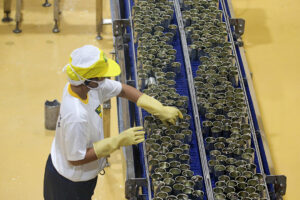FACTORY output growth slowed in June, with the 2.5% increase led by food and fabricated metal products, the Philippine Statistics Authority (PSA) said.
Output growth weakened from 3.2% growth in May but accelerated from 2.1% a year earlier, according to preliminary results of the PSA’s Monthly Integrated Survey of Selected Industries.
Factory output is measured by the volume of production index (VoPI).
Month on month, the manufacturing sector’s VoPI contracted 3.9% in June after posting 0.8% growth in May. Stripping out seasonal factors, factory output that month declined 1.3%.
In the year to date, factory output growth averaged 1.3%, slowing from 5.61% a year earlier.
The S&P Global Philippines Manufacturing Purchasing Managers’ Index (PMI) eased to 51.3 in June from 51.9 in May, pointing to further slowdowns going forward.
PMIs are a leading indicator for factory activity, reflecting the volume of materials purchased in advance of manufacturing operations weeks or months down the line. A reading above 50 marks increased purchasing activity for materials that will later be transformed into goods, while a reading below 50 means reduced purchasing.
Growth in the VoPI was led by food products (8.8% in June from -0.9% in May) and fabricated metal products, except machinery and equipment (19.6% from -8.8%).
However, slower growth in three categories impacted overall output: basic metals (-17.7% from -2.8% in May), transport equipment (-8.8% in June from -1.2% in May), and coke and refined petroleum products (46% in June from 52.7% in May).
Average capacity utilization stood at 75.3% in June, against the 73.3% posted a year earlier and 75.6% in May.
All industry categories reported average capacity utilization rates exceeding 60% for the month, with paper and paper products recording the weakest capacity utilization of 61.9%.
Leonardo A. Lanzona, who teaches economics at the Ateneo De Manila, said the lack of investment to support the manufacturing sector may have been behind the slowdown.
“During the time when the economy was still on an upward trajectory, there was no strategy to rescue the sector which had not received substantial investment. The government should have (undertaken) the necessary steps to lower cost of production, especially in energy. Instead, they had been pushing for more infrastructure that apparently had no effect on manufacturing,” he said via Messenger. — Beatriz Marie D. Cruz
